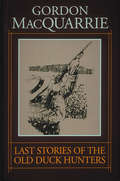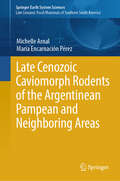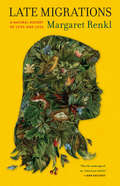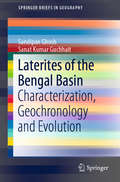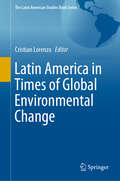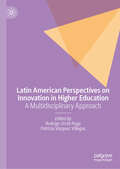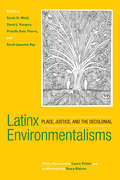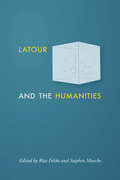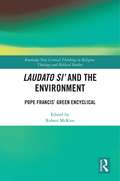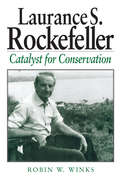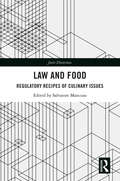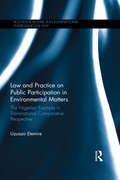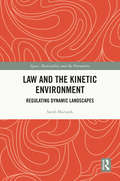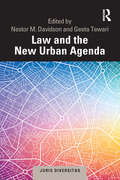- Table View
- List View
Last Stories of the Old Duck Hunters
by Gordon MacquarrieMasterpieces you can read over and over is how the Washington Post reviewed MacQuarrie's engaging, timeless stories of the misadventures of the Old Duck Hunters Association.Here are 53 classic hunting and fishing stories, some from sporting magazines of the 1930s and 1940s, including unpublished works from the author's literary estate.
Late Cenozoic Caviomorph Rodents of the Argentinean Pampean and Neighboring Areas (Springer Earth System Sciences)
by Michelle Arnal María Encarnación PérezCaviomorpha are those hystricognath rodents endemic to the Neotropics. They are the most diverse group of rodents considering their morphological disparity and biology. Their evolutionary history goes back to the Eocene (ca. 40 Ma) and their excellent fossil record indicates that this fascinating clade occupied a wide range of niches. For this contribution, we considered those caviomorph rodents that inhabited the Argentinian Pampean region, limited to the provinces of Buenos Aires and La Pampa, from the Late Miocene to the Present. During the Late Miocene, caviomorphs underwent profound changes that led to the appearance of the most modern lineages (e.g. Octodontidae, Abrocomidae, Hydrochoerinae, Caviinae, Dolichotinae, Lagostomus). Later, during the Pliocene and Pleistocene, Pampean caviomorph assemblages experienced minor changes, and just by the Pleistocene/Holocene, modern taxonomic composition was already established. These changes seem to be related to environmental changes influenced by the aridization and cooling of the southern part of South America. Owing to its geographic position, the Pampean region acted as an ecotone between the Patagonian and Brazilian faunas, becoming an interesting object of study. In this contribution, we updated the systematic paleontology of the Argentinian Pampean caviomorphs. This revised systematic paleontology will contribute to a better understanding of the biostratigraphic scheme for this region, according to the new list of exclusive taxa for each Stage/Age. It will also provide a good base for studying the major pathways in the evolution of modern caviomorph lineages and the climatic changes in southern South America since the Late Miocene.
Late Cenozoic Climate Change in Asia
by Zhisheng AnThis book is the first of its kind on environmental change research devoted to monsoon-arid environment evolution history and its mechanism involved. Capturing the most prominent features of Asian climate and environmental changes, it gives a comprehensive review of the Asian Monsoon records providing evidence for spatial and temporal climatic and environmental changes across the Asian continent since the Late Cenozoic. The dynamics underlying these changes are explored based on various bio-geological records and in particular based on the evidence of loess, speleothems as well as on mammal fossils. The Asian monsoon-arid climate system which quantifies the controlling mechanisms of climate change and the way it operates in different time scales is described. Attempts to differentiate between natural change and human-induced effects, which will help guide policies and countermeasures designed to support sustainable development on the Chinese Loess Plateau and the arid west.
Late Migrations: A Natural History of Love and Loss
by Margaret RenklFrom the New York Times columnist, a portrait of a family and the cycles of joy and grief that mark the natural world: “Has the makings of an American classic.” —Ann Patchett Growing up in Alabama, Margaret Renkl was a devoted reader, an explorer of riverbeds and red-dirt roads, and a fiercely loved daughter. Here, in brief essays, she traces a tender and honest portrait of her complicated parents—her exuberant, creative mother; her steady, supportive father—and of the bittersweet moments that accompany a child’s transition to caregiver.And here, braided into the overall narrative, Renkl offers observations on the world surrounding her suburban Nashville home. Ringing with rapture and heartache, these essays convey the dignity of bluebirds and rat snakes, monarch butterflies and native bees. As these two threads haunt and harmonize with each other, Renkl suggests that there is astonishment to be found in common things: in what seems ordinary, in what we all share. For in both worlds—the natural one and our own—“the shadow side of love is always loss, and grief is only love’s own twin.”Gorgeously illustrated by the author’s brother, Billy Renkl, Late Migrations is an assured and memorable debut.“Magnificent . . . Readers will savor each page and the many gems of wisdom they contain.” —Publishers Weekly (starred review)
Late Pleistocene and Holocene Environmental Change on the Olympic Peninsula, Washington
by Daniel G. Gavin Linda B. BrubakerThis study brings together decades of research on the modern natural environment of Washington's Olympic Peninsula, reviews past research on paleoenvironmental change since the Late Pleistocene, and finally presents paleoecological records of changing forest composition and fire over the last 14,000 years. The focus of this study is on the authors' studies of five pollen records from the Olympic Peninsula. Maps and other data graphics are used extensively. Paleoecology can effectively address some of these challenges we face in understanding the biotic response to climate change and other agents of change in ecosystems. First, species responses to climate change are mediated by changing disturbance regimes. Second, biotic hotspots today suggest a long-term maintenance of diversity in an area, and researchers approach the maintenance of diversity from a wide range and angles (CITE). Mountain regions may maintain biodiversity through significant climate change in 'refugia': locations where components of diversity retreat to and expand from during periods of unfavorable climate (Keppel et al. , 2012). Paleoecological studies can describe the context for which biodiversity persisted through time climate refugia. Third, the paleoecological approach is especially suited for long-lived organisms. For example, a tree species that may typically reach reproductive sizes only after 50 years and remain fertile for 300 years, will experience only 30 to 200 generations since colonizing a location after Holocene warming about 11,000 years ago. Thus, by summarizing community change through multiple generations and natural disturbance events, paleoecological studies can examine the resilience of ecosystems to disturbances in the past, showing how many ecosystems recover quickly while others may not (Willis et al. , 2010).
Late Victorian Holocausts
by Mike DavisExamining a series of El Niño-induced droughts and the famines that they spawned round the globe in the last third of the 19th century, Mike Davis discloses the intimate, baleful relationship between imperial arrogance and natural incident that combined to produce some of the worst tragedies in human history.<P> Late Victorian Holocausts focuses on three zones of drought and subsequent famine: India, Northern China, and Northeastern Brazil. All were affected by the same global climatic factors that caused massive crop failures, and all experienced brutal famines that decimated local populations. But the effects of drought were magnified in each case because of singularly destructive policies promulgated by different ruling elites.<P> Davis argues that the seeds of underdevelopment in what later became known as the Third World were sown in this era of High Imperialism, as the price for capitalist modernization was paid in the currency of millions of peasants' lives.
Laterites of the Bengal Basin: Characterization, Geochronology and Evolution (SpringerBriefs in Geography)
by Sandipan Ghosh Sanat Kumar GuchhaitThis Brief analyses and discusses the laterites in the Bengal Basin. The book highlights: (1) the definition, identification and classification of ferruginous materials, (2) the mode of laterite formation and its other horizons, (3) processes and theories of lateritisation, (4) determination of laterite ages, (5) recognition of palaeogeomorphic and palaeoclimatic significance and (6) geo-chronology and reconstruction of former lateritized landscapes. The chapters cover the tectono-climatic evolution of north-south laterite profiles of the north-western Bengal Basin on the Rajmahal Basalt Traps, Archean Granite-Gneiss, Gondwana Sandstones, Palaeogene Gravels and Older Palaeo-Deltaic Alluvium. The book uses advanced field-based studies, quantitative analysis and thematic mapping to cover various areas of palaeogeography and regolith geology of the Bengal Basin in connection with laterite genesis, palaeoweathering, tectonic geomorphology, Quaternary geomorphology and pedogeomorphology. It introduces laterites as a potential stratigraphic marker in Indian geology by explaining their palaeogeomorphic and palaeoclimatic significance.This Brief is a comprehensive resource to researchers, students and academicians of geography, geomorphology and geology working on laterites.
Latest Developments in Geotechnical Earthquake Engineering and Soil Dynamics (Springer Transactions in Civil and Environmental Engineering)
by T. G. Sitharam Sreevalsa Kolathayar Ravi JakkaThis volume brings together contributions from world renowned researchers and practitioners in the field of geotechnical engineering. The chapters of this book are based on the keynote and invited lectures delivered at the 7th International Conference on Recent Advances in Geotechnical Earthquake Engineering and Soil Dynamics. The book presents advances in the field of soil dynamics and geotechnical earthquake engineering. A strong emphasis is placed on proving connections between academic research and field practice, with many examples, case studies, best practices, and discussions on performance-based design. This volume will be of interest to research scholars, academicians and industry professionals alike.
Latin America in Times of Global Environmental Change (The Latin American Studies Book Series)
by Cristian LorenzoThis volume discusses the challenges of Latin America in global environmental geopolitics. Written by leading experts, this book brings together Latin American research on global environmental change. They cover a range of topics such as climate change, water, forest and biodiversity conservation connected with science policies, public opinion, priorities of international funds, and international politics of Latin American countries. The book describes the discrepancy between the international priorities and the regional needs or country interests. It includes several case studies and analyses the cooperation in multilateral negotiations on climate change. It also offers a synthesis of debates around global environmental changes and Latin American politics, which the authors have previously promoted in different academic events in South America, including in Santiago de Chile in Chile, and Buenos Aires and Ushuaia in Argentina.This book assesses the environmental problems from different perspectives, highlights the scientific development in the environmental changes affecting Latin America and offers a new view on geopolitics to help face those issues. Specialist readers in international relations, political sciences, environmental sciences, geography and geopolitics will appreciate this up-to-date examination of Latin America and the global environmental change.
Latin American Dendroecology: Combining Tree-Ring Sciences and Ecology in a Megadiverse Territory
by J. Julio Camarero Marín Pompa-GarcíaLatin America is a megadiverse territory hosting several hotspots of plant diversity and many types of forest biomes, ecosystems and climate types, from tropical rainforest to semi-arid woodlands. This combination of diverse forests and climates generates multiple responses to ecological changes affecting the structure and functioning of forest ecosystems. Recently, there have been major efforts to improve our understanding of such impacts on ecosystems processes. However, there is a dearth of studies focused on Latin-American forest ecosystems that could provide novel insights into the patterns and mechanisms of ecological processes in response to environmental stress. The abundance of “New World” tree species with dendrochronological potential constitutes an ideal opportunity to improve the ecological state of knowledge regarding these diverse forest types, which are often threatened by several impacts such as logging or conversion to agricultural lands. Thus, detailed information on the dendroecology of these species will improve our understanding of forests in the face of global change. Accordingly, this book identifies numerous relevant ecological processes and scales, ranging from tree species to populations and communities, and from both dendrochronological and dendroecological perspectives. It offers a valuable reference guide for the exploration of long-term ecological interactions between trees and their environmental conditions, and will foster further research and international projects on the continent and elsewhere.
Latin American Perspectives on Innovation in Higher Education: A Multidisciplinary Approach
by Rodrigo Urcid-Puga Patricia Vázquez VillegasThis book highlights educational innovations from Latin American researchers, offering culturally relevant practices and perspectives. This approach provides valuable and underrepresented viewpoints for a global audience interested in diverse approaches to education. It integrates theory and practice by seamlessly combining theoretical frameworks with real-world case studies, making it academically rigorous and practically applicable. This balance ensures its appeal to educators, researchers, and policymakers seeking innovative strategies. The text includes practical cases from professors that teach at undergraduate and postgraduate level, also includes some experiences reinforced with a solid theoretical framework. The different chapters aims to meet several needs, including enhancing teacher professionalization, disseminating best teaching practices, and providing first-hand access to real cases inside and outside the classroom. It also seeks to update university faculty and administrators on topics related to educational innovation while serving as a reference for undergraduate and graduate students.
Latinx Environmentalisms: Place, Justice, and the Decolonial
by Stacy AlaimoThe whiteness of mainstream environmentalism often fails to account for the richness and variety of Latinx environmental thought. Building on insights of environmental justice scholarship as well as critical race and ethnic studies, the editors and contributors to Latinx Environmentalisms map the ways Latinx cultural texts integrate environmental concerns with questions of social and political justice. Original interviews with creative writers, including Cherríe Moraga, Helena María Viramontes, and Héctor Tobar, as well as new essays by noted scholars of Latinx literature and culture, show how Latinx authors and cultural producers express environmental concerns in their work. These chapters, which focus on film, visual art, and literature—and engage in fields such as disability studies, animal studies, and queer studies—emphasize the role of racial capitalism in shaping human relationships to the more-than-human world and reveal a vibrant tradition of Latinx decolonial environmentalism. Latinx Environmentalisms accounts for the ways Latinx cultures are environmental, but often do not assume the mantle of “environmentalism.”
Latour and the Humanities
by Rita Felski and Stephen MueckeHow does the work of influential theorist Bruno Latour offer a fresh angle on the practices and purposes of the humanities?In recent years, defenses of the humanities have tended to argue along predictable lines: the humanities foster empathy, the humanities encourage critical thinking, the humanities offer a counterweight to the cold calculations of the natural and social sciences. The essays in Latour and the Humanities take a different approach. Exploring the relevance of theorist Bruno Latour's work, they argue for attachments and entanglements between the humanities and the sciences while looking closely at the interests, institutions, and intellectual projects that shape the humanities within and beyond the university. The collection, which is written by a group of highly distinguished scholars from around the world, is divided into two sections. In the first part, authors engage in depth with Latour's work while also rethinking the ties between the humanities and the sciences. Essays argue for greater attention to the nonhuman world, the urgency of climate change, and more nuanced views of universities as institutions. The second half of the volume contains essays that reflect on Latour's influence on the practices of specific disciplines, including art, the digital humanities, film studies, and political theory.Inspiring conversation about the relevance of actor-network-theory for research and teaching in the humanities, Latour and the Humanities offers a substantial introduction to Latour's work while discussing the humanities without falling back on the genres of either the sermon or the jeremiad. This volume will be of interest to all those searching for fresh perspectives on the value and importance of humanistic disciplines and thought.Contributors: David J. Alworth, Anders Blok, Claudia Breger, Dipesh Chakrabarty, Yves Citton, Steven Connor, Gerard de Vries, Simon During, Rita Felski, Francis Halsall, Graham Harman, Antoine Hennion, Casper Bruun Jensen, Bruno Latour, Heather Love, Patrice Maniglier, Stephen Muecke, Barbara Herrnstein Smith, Nigel Thrift, Michael Witmore
Laudato Si’ and the Environment: Pope Francis’ Green Encyclical (Routledge New Critical Thinking in Religion, Theology and Biblical Studies)
by Robert McKimThis volume is a response to the Pope’s Laudato Si’, giving an interdisciplinary overview of its impact on the environmental concerns of Catholics as well as other religious groups. Published in 2015, it is often seen as an "environmental" encyclical and in it the Pope urges us to face up to the crisis of climate change. He argues that all of us should prioritise taking better care of the Earth, our common home, while also attending to the plight of the poor. Written by an international and multidisciplinary team of leading scholars, the Pope’s invitation to all people to begin a new dialog about these matters is considered from a variety of perspectives. There is discussion of the implications for immigration, population control, eating animals, and property ownership. Additionally, indigenous religious perspectives, development and environmental protection, and the implementation of the ideas of the encyclical in the Church are explored. Each chapter deals with the scriptural, theological, and philosophical underpinnings of the encyclical, as well as other central concepts such as interconnectedness, the role of practice, and what Pope Francis calls the "technocratic paradigm". This book expertly illuminates the relationship between Laudato Si’ and environmental concerns. It will, therefore, be vital reading for anyone studying religion and the environment, environmental ethics, Catholic theology, and environmental thought.
Laurance S. Rockefeller: Catalyst For Conservation
by Robin W. Winks Bruce BabbittDespite his status as a scion of one of the wealthiest and most famous families in the United States and an enormously successful businessman in his own right, Laurance S. Rockefeller is unknown to all but a few Americans. Yet while he has been neither Vice President nor Governor nor chairman of the world's largest bank, his contribution to society has been at least as great as that of his more famous brothers. In Laurance S. Rockefeller: Catalyst for Conservation, noted historian Robin W. Winks brings Laurance to the forefront, offering an intimate look at his life and accomplishments. While Rockefeller has played a vital role in the business world as one of the most astute venture capitalists of our time--providing seed money for, among other endeavors, Eastern Airlines, Intel Corporation, and Apple Computers--his driving passion throughout his life has been the environment In addition to donating millions of dollars and the helping to found numerous conservation organizations, he served under five consecutive presidents in environmental advisory capacities. As chairman of the Outdoor Recreation Resources Review Commission (ORRRC) under Presidents Eisenhower and Kennedy, Rockefeller orchestrated an assessment of the recreation and conservation needs of the American people and the policies and programs required to meet those needs. The reports issued by the Commission are a groundbreaking achievement that laid the framework for nearly all significant environmental legislation of the following three decades. Winks uses a combination of historical insight and extensive research to present the first in-depth examination of Laurance Rockefeller's life and work. His book explores Rockefeller's role in the transition from traditional land conservation to a more inclusive environmentalism. It compels broader interpretation of the history of environmental protection, and is essential reading for anyone concerned with the past or future of conservation in America.
Lavender: The Grower's Guide
by Virginia McnaughtonA book on different types of lavender and how to grow them
Law and Ecology: The Rise of the Ecosystem Regime (Ecology and Law in Modern Society)
by Ross Jones Richard O. BrooksIn 1970 Earth Day was first celebrated marking the dawn of worldwide environmental consciousness and the passing of many environmental laws. In part, these events were the result of the maturing of the science of ecology which recognized the interdependence of the web and cycles of nature. This volume explores the relationship between ecology and environmental law, beginning with a description of the two very different disciplines. This description is followed by a history of their episodic interactions: the early period of origin, the mid-century formative period from 1950 to 1970, the initial serious period of interaction after Earth Day in 1970 and the testing of the relationship during the next two decades. Utilizing a number of case studies, examinations of the key 'linkage persons', legal instruments and the migration of ecological concepts and frameworks, this book analyzes the final flowering of an ecosystem regime which embraces the connections between the two disciplines of ecology and environmental law. Concluding with an inventory of the problems posed by the relationship between the two disciplines and an agenda for future research, this clearly structured, comprehensive and stringent book is an essential resource for all serious scholars and students of ecology and environmental law.
Law and Emerging Issues: Proceedings of the International Conference on Law and Emerging Issues (ICLEI 2023)
In the ever-evolving landscape of law and governance, adaptation and innovation are key to addressing the challenges of our times. This edited volume is a testament to the ever-evolving nature of the legal field and the ongoing efforts of legal scholars and academicians to dissect, analyze, and grapple with the challenges and opportunities presented by these changes. The topics covered in this book span a wide spectrum of legal domains, reflecting the complex and rapidly changing nature of our contemporary world. From corporate governance structures to emerging challenges in the digital space, from analyzing the implications of the Social Security Code 2020 in India to understanding the legal developments surrounding unorganized migrant workers during the COVID-19 pandemic, the breadth of subjects addressed here is both impressive and vital.
Law and Food: Regulatory Recipes of Culinary Issues (Juris Diversitas)
by Salvatore MancusoThis book presents a range of insights on the relationship between food and law. Over time, religions have multiplied food prohibitions and prescriptions, customs have redistributed land, shared its occupancy in creative ways, or favoured communal property so that everyone could have access to food. In turn, laws have multiplied to facilitate food trade, security, safety, traceability, and also to promote and protect food and wine production, using trademarks and geographical denominations. This volume brings a comparative and interdisciplinary approach to examine some of the most heavily debated issues in the interaction between food, in all forms, and the law. Topics covered include food security, food safety, food quality, intellectual property, and consumer protection. As well as highlighting current issues, the work also points to new challenges in this field. The book will be a valuable resource for researchers and policy-makers working in the area of Food Law and Comparative Law.
Law and Intangible Cultural Heritage in the City
by Sara Gwendolyn RossWith disappearing music venues, and arts and culture communities at constant risk of displacement in our urban centers, the preservation of intangible cultural heritage is of growing concern to global cities. This book addresses the role and protection of intangible cultural heritage in the urban context. Using the methodology of Urban Legal Anthropology, the author provides an ethnographic account of the civic effort of Toronto to become a Music City from 2014-18 in the context of redevelopment and gentrification pressures. Through this, the book elucidates the problems cities like Toronto have in equitably protecting intangible cultural heritage and what can be done to address this. It also evaluates the engagement that Toronto and other cities have had with international legal frameworks intended to protect intangible cultural heritage, as well as potential counterhegemonic uses of hegemonic legal tools. Understanding urban intangible cultural heritage and the communities of people who produce it is of importance to a range of actors, from urban developers looking to formulate livable and sustainable neighbourhoods, to city leaders looking for ways in which their city can flourish, to scholars and individuals concerned with equitability and the right to the city. This book is the beginning of a conservation about what is important for us to protect in the city for future generations beyond built structures, and the role of intangible cultural heritage in the creation of full and happy lives. The book is of interest to legal and sociolegal readers, specifically those who study cities, cultural heritage law, and legal anthropology.
Law and Practice on Public Participation in Environmental Matters: The Nigerian Example in Transnational Comparative Perspective (Routledge Research in International Environmental Law)
by Uzuazo EtemirePublic participation has become a recurring theme and a topical issue in the field of international environmental law, with many multilateral environmental instruments calling on states to guarantee effectively the concept in their laws and practices. This book focuses on public participation in environmental governance, in terms of public access to environmental information and public participation in environmental decision-making processes. Drawing on the body of international best practice principles in environmental law and taking a comparative stance, Uzuazo Etemire takes Nigeria as a key case, evaluating its procedural laws and practices in relation to public access to information and participation in decision-making in environmental matters. In working to clarify and deepen understanding of the current status of environmental public participation rights in Nigeria, the book addresses key issues in environmental governance for developing and transitional countries and the potential for public participation to improve the state of the environment and public wellbeing. This book will be of great interest to undergraduate students (as further reading) and post-graduate students, academics, researchers, relevant government agencies and departments, policy-makers and NGOs in the fields of international environmental law, environmental justice, environmental/natural resource management, development studies and international finance.
Law and the Kinetic Environment: Regulating Dynamic Landscapes (Space, Materiality And The Normative Ser.)
by Sarah MarusekThis book addresses the legal-geographical implications of the fact that landscapes are not static, but dynamic. Within the field of legal geography, the spatial relationship of law to landscape is usually considered to be static. Environments are often considered fixed, and consequently inert, as places that literally don’t go anywhere. Typically, then, it is what happens in these places, rather than the place itself, that commands academic attention. In contrast to this static viewpoint, Law and the Kinetic Environment considers how many landscapes are in flux and, as a result, may be seen as dynamic. Natural phenomena, such as oozing lava, moving glaciers, or bubbling geothermal pools, challenge and test the normative conceptualizations of stability of place, property ownership, and legal regulation. Consequently, such dynamic landscapes enliven and transform law, offering new jurisprudential insights into what law is and how it operates in response to the kineticism that, this book argues is, to some degree, inherent in all landscapes. This original engagement with legal geography will appeal to those with general interests in this area, as well as specific concerns with questions of law and place, property and the environment.
Law and the New Urban Agenda: A Comparative Perspective (Juris Diversitas)
by Nestor M. Davidson Geeta TewariThe New Urban Agenda (NUA), adopted in 2016 at the United Nations Conference on Housing and Sustainable Urban Development (Habitat III) in Quito, Ecuador, represents a globally shared understanding of the vital link between urbanization and a sustainable future. At the heart of this new vision stand a myriad of legal challenges – and opportunities – that must be confronted for the world to make good on the NUA’s promise. In response, this book, which complements and expands on the editors’ previous volumes on urban law in this series, offers a constructive and critical evaluation of the legal dimensions of the NUA. As the volume’s authors make clear, from natural disasters and resulting urban migration in Honshu and Tacloban, to innovative collaborative governance in Barcelona and Turin, to accessibility of public space for informal workers in New Delhi and Accra, and power scales among Brazil’s metropolitan regions, there is a deep urgency for thoughtful research to understand how law can be harnessed to advance the NUA’s global mission of sustainable urbanism. It thus creates a provocative and academic dialogue about the legal effects of the NUA, which will be of interest to academics and researchers with an interest in urban studies.
Law and the Question of the Animal: A Critical Jurisprudence (Law, Justice and Ecology #1)
by Yoriko Otomo Ed MussawirThis book addresses the problem of ‘animal life’ in terms that go beyond the usual extension of liberal rights to animals. The discourse of animal rights is one that increasingly occupies the political, ethical and intellectual terrain of modern society. But, although the question of the status of animals holds an important place within a range of civil, political and technological disciplines, the issue of rights in relation to animals usually rehearses the familiar perspectives of legal, moral and humanist philosophy. ‘Animal law’ is fast becoming a topic of significant contemporary interest and discussion. This burgeoning interest has not, however, been matched by renewed inquiry into the jurisprudential frames and methods for the treatment of animals in law, nor the philosophical issue of the ‘human’ and the ‘animal’ that lies at law’s foundation. Responding to this interest, Law and the Question of the Animal: A Critical Jurisprudence brings together leading and emerging critical legal theorists to address the question of animality in relation to law’s foundations, practices and traditions of thought. In so doing, it engages a surprisingly underdeveloped aspect of the moral philosophies of animal rights, namely their juridical register and existence. How does ‘animal law’ alter our juridical image of personality or personhood? How do the technologies of law intersect with the technologies that invent, create and manage animal life? And how might the ethical, ontological and ceremonial relation between humans and animals be linked to a common source or experience of law?
Law as if Earth Really Mattered: The Wild Law Judgment Project (Law, Justice and Ecology)
by Nicole Rogers Michelle MaloneyThis book is a collection of judgments drawn from the innovative Wild Law Judgment Project. In participating in the Wild Law Judgment Project, which was inspired by various feminist judgment projects, contributors have creatively reinterpreted judicial decisions from an Earth-centred point of view by rewriting existing judgments, or creating fictional judgments, as wild law. Authors have confronted the specific challenges of aligning existing Western legal systems with Thomas Berry’s philosophy of Earth jurisprudence through judgment writing and rewriting. This book thus opens up judicial decision-making and the common law to critical scrutiny from a wild law or Earth-centred perspective. Based upon ecocentric rather than human-centred or anthropocentric principles, Earth jurisprudence poses a unique critical challenge to the dominant anthropocentric or human-centred focus and orientation of the common law. The authors interrogate the anthropocentric and property rights assumptions embedded in existing common law by placing Earth and the greater community of life at the centre of their rewritten and hypothetical judgments. Covering areas as diverse as tort law, intellectual property law, criminal law, environmental law, administrative law, international law, native title law and constitutional law, this unique collection provides a valuable tool for practitioners and students who are interested in learning more about the emerging ecological jurisprudence movement. It helps us to see more clearly what a new system of law might look like: one in which Earth really matters.
